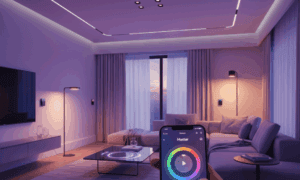India leads the world in web design company services, and the numbers prove its dominance in the global market. A.T. Kearney’s Global Services Location Index ranks India as the top outsourcing destination in 2019. The country’s strong 9.5% employability rate in HTML/CSS skills supports this position.
Professional web design companies in India have shown outstanding results in UI/UX development. To cite an instance, 10-year old firms have delivered thousands of successful projects. Some companies have completed more than 4,000 web solutions. Indian companies attract more businesses that need custom web design services because of their technical expertise and creative skills.
This piece dives into the UI design principles that will transform the industry in 2025. It focuses on new technologies, accessibility standards, and performance optimisation strategies that UI/UX designers need to become skilled at to stay ahead of the competition.
Core UI Design Principles for 2025
UI design success depends on basic principles that shape how users experience websites. Web design companies know these core principles will change by a lot by 2025. They adapt to new user needs and tech capabilities.
Minimalism and white space
Minimalist design removes extra elements but keeps everything working. Users focus better on their tasks when interfaces are clean and clutter-free. Designers create streamlined layouts and highlight what matters most. This helps reduce the mental effort users need.
White space (or negative space) plays a vital role in modern interfaces. The right amount of space makes content easier to read. Space between elements also shows how different content sections connect. This makes the interface more user-friendly.
Visual hierarchy and flow
Visual hierarchy guides information from system to user. It points attention to key elements based on their importance. Designers use several methods to build this hierarchy:
-
Size and Scale: Bigger elements grab more attention, perfect for main content
-
Typography: Smart font choices in weight and size create clear content order
-
Spacing: Smart element placement on both axes highlights important info
Balance and alignment create effective visual hierarchies. Research shows users see UI elements placed close together as connected. This makes proximity a powerful way to organise content.
Colour psychology and accessibility
Colours shape user behaviour and engagement deeply. Studies show it takes 90 seconds for users to form opinions about products. About 90% of that judgement comes from colour alone. Web design companies carefully think about these effects when building interfaces.
Accessibility stays at the top of colour choices. The main points include:
-
Making sure text and backgrounds have enough contrast
-
Using more than just colour to share information
-
Adding other ways to identify things for colour-blind users
The 60-30-10 rule offers a balanced way to use colour:
-
60% has the main, usually neutral colour
-
30% uses a matching secondary colour
-
10% goes to accent colours that catch the eye
This well-laid-out approach creates attractive interfaces while meeting accessibility standards. Web design companies also know that different cultures see colours differently. They look at their target audience’s background when picking colour schemes.
Data-Driven UI Design Approaches
Modern UI design depends heavily on informed approaches to create interfaces that strike a chord with users. Web design companies utilise analytics and testing methods to craft experiences based on real user behaviour instead of assumptions.
User behaviour analytics
Informed design combines quantitative and qualitative insights to shape effective user interfaces. Designers monitor several metrics to learn about user interaction with digital products. These include:
-
Bounce rates and average session duration
-
Conversion rates and engagement patterns
-
Primary age group and geographical data
-
Product views and recommendations
Behavioral analytics give detailed insights about user actions and engagement patterns. Tools like Google Analytics and Hotjar help designers identify successful elements that users like and features they rarely use.
Web design companies in India use Voice of Customer (VoC) strategies to collect detailed user feedback. This method has data from:
-
On-site surveys and customer interviews
-
Live chat interactions
-
Social media discourse
Quantitative metrics combined with qualitative insights help UI/UX designers understand user priorities and pain points better. This all-encompassing approach will give continuous improvement of user experience based on real behaviour patterns rather than assumptions.
A/B testing strategies
A/B testing is the life-blood of informed design. Designers can compare different versions of interface elements to find optimal solutions. Studies show that companies like Spotify improved user engagement by 30% through personalized recommendations based on A/B testing results.
Web design companies use systematic testing approaches:
-
Clear Goal Definition: Specific objectives and metrics must be set before tests begin
-
Element Isolation: One component at a time needs testing to measure effects accurately
-
Statistical Significance: Tests need sufficient duration to gather meaningful data
Research reveals that simpler sign-up processes through A/B testing led to a 10% increase in conversions. Notwithstanding that, designers must avoid common pitfalls such as:
-
Testing too many elements simultaneously
-
Ending tests prematurely
-
Neglecting external factors like seasonality
Responsive web design companies in India now combine A/B testing with other optimisation strategies. Test results work together with Conversion Rate Optimisation (CRO) techniques to create more effective user experiences.
A/B testing eliminates guesswork from the design process. Systematic testing of different variations helps designers make informed decisions based on actual user interactions instead of assumptions. This informed approach ensures that UI changes improve user experience rather than just following design trends.
Emerging UI Technologies
The digital world of UI design keeps evolving and brings new ways for users to interact with digital interfaces. Web design companies adapt to these changes, especially in three areas that have altered the map of the industry.
AI-powered interfaces
Artificial Intelligence has changed UI design into a personalized trip. Studies show that users expect applications to predict their needs and provide content and features that feel custom-made. AI will shape modern interfaces beyond simple content recommendations in 2025. It will adjust layouts, menu structures, and even colour schemes to match individual priorities.
Web design companies in India use AI chatbots that understand context and predict user needs. These systems can detect emotional tone and help users before they ask questions. AI analyses user behaviour through advanced algorithms to create seamless digital interactions that improve engagement and accessibility.
Voice and gesture controls
Voice-based interfaces have grown remarkably, with approximately 4.2 billion active voice assistants worldwide in 2023. This number will reach 8.4 billion by 2024. Web design companies add voice capabilities to improve accessibility. These features are especially useful in:
-
Healthcare settings for accessing vital information hands-free
-
Smart home control if you have mobility challenges
-
Vehicle interfaces for safer, distraction-free operation
Gesture-based controls bring opportunities and challenges. They offer easy-to-use ways to interact with digital systems, but designers must solve issues like:
-
Accuracy and precision compared to traditional input methods
-
Physical demands and potential user fatigue
-
Accessibility considerations if you have limited mobility
Augmented reality elements
Augmented Reality (AR) has added new dimensions to UI design through spatial mapping and anchoring. Web design companies use advanced computer vision techniques, including simultaneous localization and mapping (SLAM), to place virtual objects accurately in real-life environments.
AR interfaces need careful thought about three key interaction paradigms:
-
Fixed to screen space: Elements locked to the screen without real-life relation
-
Real world related: UI components that respond to the physical environment
-
Object related: Interface elements attached to specific real-life triggers
UX web design companies focus on spatial awareness and smooth blending of virtual and physical elements. Designers ensure virtual objects appear anchored to their intended real-life locations through precise spatial mapping. But they must manage factors like occlusion, transparency, and depth cues to create realistic and immersive experiences.
UI web design companies know that AR interfaces need unique approaches to user interaction. The technology must work with various environmental factors, including lighting conditions, human interaction patterns, and random elements beyond control. Designers must create adaptive interfaces that work in a variety of scenarios while keeping users engaged.
Accessibility in Modern UI
Modern UI design prioritises making interfaces available to everyone. Recent statistics suggest that 61 million adults in the United States live with a disability. Web design companies know that designing for accessibility boosts usability for all users.
Universal design principles
Universal design creates products and environments that everyone can use without adaptation or specialised design. Web design companies apply these principles through several approaches:
Equitable Use: Interfaces must work for users of all abilities to ensure equal access to information and functionality. This approach saves money and promotes innovation in product development.
Flexibility in Use: Designs should work with different priorities and abilities. They need options that appeal to the widest possible user base. UX web design companies achieve this through:
-
Adjustable text sizes and contrast settings
-
Multiple navigation options
-
Customizable interface elements
Simple and Intuitive: Users should find interfaces easy to understand, whatever their experience or concentration level. UI web design companies do this by:
-
Creating clear layouts with distinct calls to action
-
Adding easily identifiable feedback
-
Using consistent navigation patterns
Inclusive typography choices
Typography significantly impacts accessibility. Studies show that certain letters and symbols often confuse users aged 13 to 45, even without disabilities. Web design companies focus on several typography aspects to improve readability:
Font Selection: Tahoma, Calibri, Helvetica, Arial, Verdana, and Times New Roman rank among the most accessible fonts. Web design companies choose these typefaces for their:
-
Large, open counters for character recognition
-
Distinct features that set similar characters apart
-
Appropriate x-height for better readability
Size and Spacing: Body copy needs a minimum size of 16px. Line height should equal 120% of the font size for better readability. Web design companies in India create proper spacing through:
-
Adequate white space between elements
-
Consistent line spacing
-
Clear visual hierarchies
Contrast and Legibility: WCAG guidelines require a minimum contrast ratio of 4.5:1 between text and background. This requirement helps users with low vision or colour blindness read better. Colour blindness affects approximately 350 million people globally.
Research shows that 67.5% of screen reader users navigate websites through headings. Web design companies include proper heading structures and descriptive labels in their designs. Universal design and inclusive typography help create interfaces that work for everyone, whatever their abilities or circumstances.
Performance Optimisation
Speed and efficiency are the life-blood of successful UI design in 2025. Studies show that users abandon websites 32% more often when pages take three seconds to load instead of one.
Loading speed improvements
Web design companies quickly implement several proven techniques to boost page loading. Image and visual content optimisation plays a significant role since these elements use substantial resources. Designers can reduce file sizes while keeping quality intact through proper compression and format selection.
Time to First Byte (TTFB) measures how quick browsers receive original data from servers. Web design companies boost TTFB through:
-
Server-side optimisation
-
Efficient database management
-
Strategic content delivery networks
Users expect websites to load within 2-4 seconds. Load times of five seconds cause bounce rates to jump by 90%.
Resource efficiency
Web design companies apply eco-friendly approaches to manage resources. Clean, efficient code reduces computational needs and ends up lowering energy consumption. This approach includes:
Asset Optimisation: Designers compress and optimise visual content by choosing formats like SVG for vector graphics and WebP for images. These choices ensure peak performance on all devices while maintaining visual quality.
Code Minification: Web design companies strip unnecessary characters from code files to decrease their size without affecting functionality. Pages load faster and use fewer resources through this process.
Browser Caching: Browser caching helps repeat visitors load pages quick since resource files stay stored locally. Server loads decrease and overall performance improves naturally.
Mobile responsiveness
Mobile devices now account for 61% of digital content access. Performance optimization for mobile has become vital. Web design companies focus on several key areas:
Adaptive Layouts: Interfaces blend naturally with screens of all sizes and orientations. Steven Hoober’s research reveals that about half of mobile users operate devices with one hand, making thumb-friendly design vital.
Touch Targets: Web design companies in India ensure interactive elements meet size requirements – 44pt for iOS and 48dp for Android. User satisfaction and accuracy improve across mobile platforms.
Text Readability: Body text maintains a minimum size of 16px and scales up to 200% for better accessibility. Proper contrast ratios between text and background colours keep content readable on all devices.
These optimisations help web design companies achieve a 75% higher conversion rate compared to non-responsive sites. Automated testing becomes more efficient since developers verify one version of the application across multiple devices.
Conclusion
UI design principles keep changing faster as technology advances and user expectations shift. Designers who excel at these key elements create exceptional digital experiences. Their expertise ranges from minimalist approaches to analytical decision-making.
AI-powered interfaces and AR elements bring exciting new possibilities to the field. However, successful implementation relies on strong basic principles. Accessibility plays a crucial role, particularly with users who have different needs and abilities.
Performance optimization forms the foundation of good UI design. Quick-loading, efficient interfaces that work naturally across devices positively affect user satisfaction and conversion rates. Web design companies that focus on these elements while keeping designs clean and uncluttered will lead the industry in 2025 and beyond.
FAQs
1. What are the key UI design principles for 2025?
The key principles include minimalism, effective use of white space, strong visual hierarchy, and colour psychology. Designers should also focus on data-driven approaches, emerging technologies like AI and AR, and ensuring accessibility for all users.
2. How will AI impact UI design in the coming years?
AI is set to revolutionise UI design by creating highly personalised user experiences. It will adapt layouts, menu structures, and even colour schemes based on individual user preferences and behaviour patterns.
3. Why is accessibility important in modern UI design?
Accessibility ensures that digital interfaces can be used by everyone, regardless of their abilities. It not only serves users with disabilities but also enhances usability for all users, potentially reaching a wider audience and improving overall user satisfaction.
4. What role does performance optimization play in UI design?
Performance optimization is crucial for UI design as it directly impacts user satisfaction and conversion rates. Fast-loading, resource-efficient interfaces that work seamlessly across devices are essential for retaining users and reducing bounce rates.
5. How can designers create more inclusive typography in their UI designs?
Designers can create inclusive typography by selecting accessible fonts, maintaining appropriate text sizes (minimum 16px for body copy), ensuring proper contrast ratios, and implementing consistent line spacing. These practices enhance readability for all users, including those with visual impairments.

































